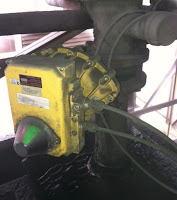 |
| Hog fuel boiler actuator. |
Hog fuel boilers are wood-fired boilers used predominantly in paper mills, sawmills, and wood processing plants. The term “hog fuel” refers to the wide variety of wood and wood wastes used to feed the boilers (called hogged fuel). Hog fuel contains wood residue, wood waste products, bark, sawdust, planer shavings, and wood chunks that are processed into coarse chips and clumps.
The ash from burning wood and wood wastes has a very high pH, high enough to make the wood ash exhibit a corrosive characteristic, which must be considered when selecting valves and actuators. All equipment in contact, or in close proximity, to this ash must stand up to the wet, corrosive, and dirty environment.
To facilitate the removal and transport of the ash, water is introduced for handling and management, thus creating corrosive slurries. Control valves with pneumatic actuators are used to control water flow and slurry flow. The environment is extremely dirty, and as mentioned above, corrosive. Any equipment connected to this process must be designed with performance and maintenance in mind.
Kinetrol rotary vane actuators, spring return units, and EL positioners
are ideal for this type of service. Standard design features such as epoxy enamel finishes, stainless steel screws, sealed housings, and direct mount configurations provide an automation package that is proven to outlast other types of actuators and assemblies in very challenging environments.







